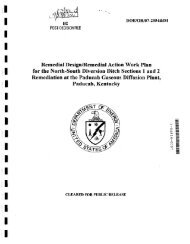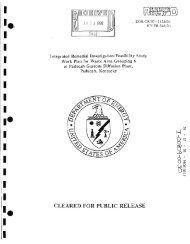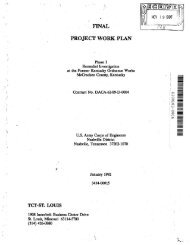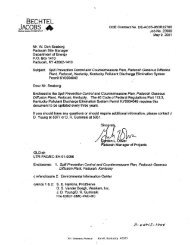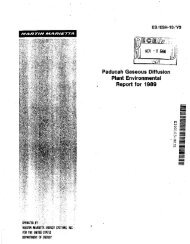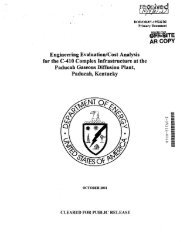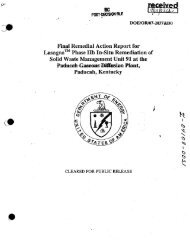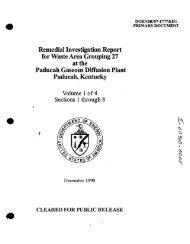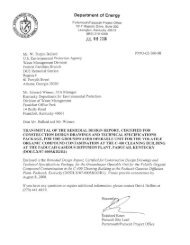1 - paducah environmental information center
1 - paducah environmental information center
1 - paducah environmental information center
You also want an ePaper? Increase the reach of your titles
YUMPU automatically turns print PDFs into web optimized ePapers that Google loves.
Paducah Site<br />
at the south end of the plant. The sediments<br />
deposited on this erosional surface are termed<br />
continental deposits. The lower portion of the<br />
continental' deposits dmsists of approximately 9<br />
m (30 ft) of stream gravel and sand.<br />
Over time, sediments from the retreating<br />
glaciers dammed the river valley, causing the<br />
formation of a lake. Silts and clays with thin<br />
zones ofsapd and occasional gravel were<br />
deposited in the lake, forming the upper portion<br />
of the continental deposits. These deposits range<br />
from approximately 1.5 to 17 rh (5 to 55 ft) thick.<br />
Finally, loess, a wind~blown silt, overlies<br />
the continental" deposits throughout the site.<br />
Thickness of loess deposits varies f~om<br />
approximately 1.5 to 8 m (5 to 25 ft), averaging<br />
approximately 4.6 II1 (15 ft). 'The local<br />
groundwater flow system at the Paducah, Site<br />
contains four major components: the McNairy<br />
flow system, the Regional Gravel Aquifer<br />
(RGA), the Upper Continental Recharge System<br />
(VCRS), and the terrace gravels.<br />
• The McNairy flow system consists<br />
, of interbedded and interlensing sand,<br />
silt, and clay of the McNairy Formation.<br />
"Sand facies ,account for 40 to 50% of the<br />
'total formation thickness of<br />
approximately 69 m (225 ft).<br />
• TheRGA consists of san4 and gravel<br />
facies in the lower continent3I deposits,<br />
gravetand coarse sand portions in the<br />
upper McNairy that are directly adjacent<br />
to ,the lower continental deposits, coarse~<br />
grhlned sedimfmts at the base of 'the<br />
upper continental deposits, and alluvium<br />
adjacent to the Ohio River. These<br />
depo'sits have an average thickness of 9<br />
m (30 ft) and range up to 21 m (70 ft)<br />
along an axis that trends east-west<br />
'through the site. The RGA is the<br />
uppermost and primary aquifer, formerly<br />
used by private residences north of the<br />
Paducah Site.<br />
• The UCRS consists mainly of clayey<br />
silt with interbedded sand and gravel in<br />
the upper continental deposits. The<br />
system is so named because of its<br />
characteristic recharge to the RGA.<br />
• The terrace gravels consist of<br />
shallow Pliocene gravel deposits in the<br />
southern portion of the plant site. These<br />
deposits usually lack sufficient thickness<br />
and saturation to constitute an aquifer<br />
but 'may be an important source of<br />
groundwater recharge to the RGA.<br />
Groundwater flow ongmates south of the<br />
Paducah Site within Eocene sands and the<br />
terrace gravels. Groundwater within the terrace<br />
gravels either discharges to local streams or<br />
recharges the RGA, although the flow regime of<br />
the terrace gravels is not fully understood.<br />
Groundwater flow through ,the UCRS is<br />
ultimately downward, also recharging the RGA.<br />
From the plant site, groundwater flows generally<br />
northward in the RGA toward the Ohio River, the<br />
local base level for the system.<br />
Uses of Groundwater in the<br />
Vicinity<br />
The WKWMA and some lightly populated<br />
farmlands are in the immediate vicinity of the<br />
Paducah Site. Homes are sparsely located along<br />
rural roads in the vicinity of the site. Three<br />
communities lie within 3.2 kilometers (2 miles)<br />
of the plant: Magruder Village to the southwest<br />
and Grahamville and Heath to the east.<br />
Both groundwater and surface water<br />
sources have been used for water supply to<br />
residents and industries in the plant area. Wells<br />
in the area are screened at depths ranging from<br />
4.6 to 75 m (15 to 245 ft). The majority of these<br />
wells are believed to' be screened in the RGA.<br />
The Paducah Site continues to provide<br />
municipal water to all residents within the area of<br />
9-8 '<br />
Groundwater



